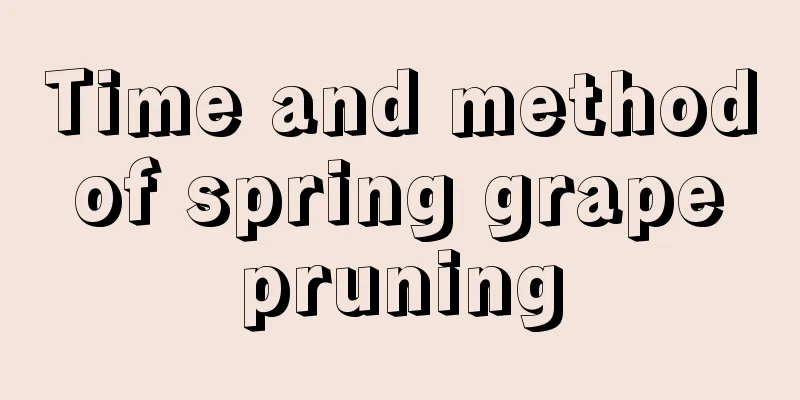Time and method of spring grape pruning

|
Grape is a perennial vine with very long branches. Spring pruning can control tree vigor, adjust the balance between growth and fruiting, promote the growth of new shoots, and lay the foundation for summer pruning. Below, the editor will introduce the time and method of spring pruning of grapes. Let’s take a look. 1. Spring grape pruning time The best time for spring pruning of grapes is usually between the end of winter and the beginning of spring, that is, February to early April. The exact timing varies by region, climate and grape variety. In southern regions, pruning may be done a little later due to relatively high temperatures. In northern regions, due to lower temperatures, pruning may need to be advanced to ensure that the vines can recover quickly and grow healthily after pruning. 2. Grape pruning method in spring 1. Remove the buds When the length of the new grape shoots reaches about 5 cm, the bud removal is carried out. Keep the strong buds and remove the weak buds, multiple buds and sprouting buds. Buds with inflorescences are retained, and buds without inflorescences are removed; if both buds have inflorescences, both are retained. 2. Thinning branches When the new shoots reach 15-20 cm in length, thinning should be carried out. Choose the branches to retain based on the size and distribution of the inflorescence. When cultivating on a single trellis, retain a new shoot every 10 cm; when cultivating on a double trellis, retain a new shoot every 15 cm. 3. Picking 3-5 days before flowering to the early flowering period, pinch off the fruiting branches, leaving 4-6 leaves above the inflorescence. Depending on the growth conditions and shelf space, pinch off the nutrient branches when they have 8-10 leaves. 4. Side shoot treatment Keep 1-2 lateral shoots on the top of the fruiting branches, leave 2-3 leaves on each lateral shoot and pinch them repeatedly, and remove all other lateral shoots. Depending on the space and growth conditions, some side shoots on the nutrient branches should be appropriately retained and pinched or shortened. 5. Thinning and pinching ear tips After fruit setting, thin out the clusters according to tree vigor and variety characteristics, removing excessive, too small, and too dense clusters. Generally, retain 1-2 clusters on each fruiting branch. Pinch the tips of the retained clusters and remove 1/4-1/5 of the top to make the clusters compact and the fruits uniform in size. The above is an introduction to the time and method of spring pruning of grapes. Spring pruning of grapes should be completed before the sap flow period to avoid sap flow caused by improper pruning. After pruning, the branches should be tied to the frame in time to keep them neat and ventilated. This is conducive to the healthy growth of the vines and the even ripening of the fruit.
|
<<: How and when to plant arrowhead mushrooms
>>: Passion fruit planting methods and management techniques
Recommend
Is azalea easy to grow? How to grow it at home and what to pay attention to
Is azalea easy to grow? Azalea is relatively easy...
When is the best time to harvest Panax notoginseng? What is the best month to harvest?
Panax notoginseng harvest time Panax notoginseng ...
Can rice water be used to water the peace tree? The correct way to water rice water
Watering the Peace Tree with Rice Washing Water R...
Cultivation methods and precautions of the fortune tree
1. Breeding methods 1. Watering: It does not like...
Cultivation method of Schefflera variegated
1. Soil selection The most important thing is to ...
How to prune ping pong chrysanthemum (pruning time and method)
When to prune chrysanthemums It is best to wait u...
What are the advantages and disadvantages of using enzymes to water flowers? What flowers are suitable for using enzymes to water them?
Benefits of Enzyme Watering Enzymes are rich in n...
What is the best fertilizer for peppers?
Fertilizing time for peppers 1. After planting pe...
How to keep baby's breath in winter
1. Ensure the temperature The temperature suitabl...
What is the difference between Qianchuan and Xiaomixing?
introduce Money String The leaves of the money st...
How to propagate the safflower
Artificial transplantation Zhaoshanbai prefers ac...
Why doesn't the African violet bloom?
Reasons why African violets do not bloom The infl...
What to do if white bugs grow on succulent plants
What to do if succulent plants have white bugs Wh...
How to fertilize Magnolia
1. Fertilization time 1. Growth period: The most ...
Tips for sending flowers on New Year's Day
1. Cymbidium New Year's Day is the first day ...









